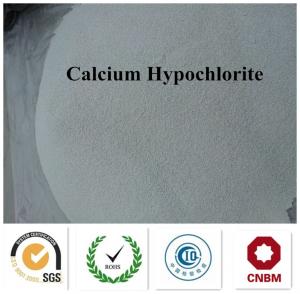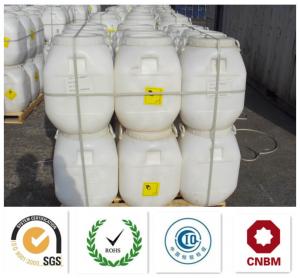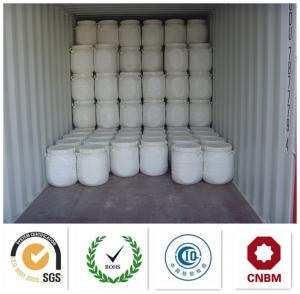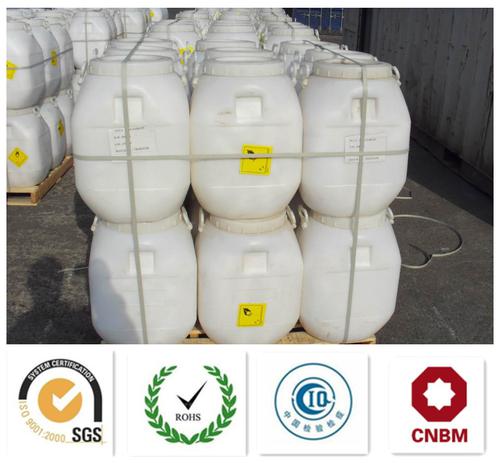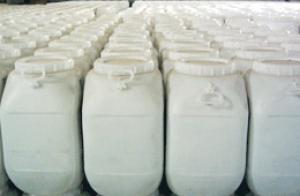Calcium Hypochlorite Powder
- Loading Port:
- Tianjin
- Payment Terms:
- TT OR LC
- Min Order Qty:
- -
- Supply Capability:
- 2000 m.t./month
OKorder Service Pledge
OKorder Financial Service
You Might Also Like
Calcium Hypochlorite
Introduction:
CNBM GROUP is the biggest water Treatment Factory in China. Our Product include: Calcium Hypochlorite, TCCA, SDIC, PAC, Sodium Sulphite, Sodium Thiosulfate etc.
CNBM One year can produce 18,000MT Calcium Hypochlorite with two model, one is 65% and one is 70%. More important we have 3 advantages, Firstly: High effective chlorine content Secondly: Good stability. Can be stored a long time at normal temperature with little chlorine loss; Third:Good solubility, less water-insoluble matters.
Technical Specifications:
Calcium Hypochlorite 65%
Index Name | Top Grade | First Grade |
Chlorine Content ≥ | 65% | 60% |
Moisture ≤ | 3% | 3% |
Yearly Loss of Active Chlorine | 8% | 8% |
Calcium Chloride | 9% | 10% |
Color | White or Light-grey | ----- |
Shape | Power & Granular |
|
Calcium Hypochlorite 70%
Index Name | Top Grade | First Grade | Quality Product |
Chlorine Content ≥ | 70% | 67% | 65% |
Granularity(14-50 mesh)% ≥ | 90 | 87 | 87 |
Moisture % | 5.5~10 |
|
|
Tablets Forms
Weight | 200 gram | 150gram | 100gram | 50gram | 30gram | 20gram | 15gram | 10gram |
Diameter(mm) | 76 | 70 | 50 | 42 | 30 | 30 | 30 | 30 |
Height(mm) | 25 | 21 | 26 | 27 | 22 | 16 | 12 | 8 |
Applications:
1. For bleaching purpose of wood pulp, silk, cloth and fibre.
2. Disinfection and water-treatment.
3. Disinfectant for chemical poisonous and radioactive substance.
Formula Experiment Design: (Base on 1MT Water)
Constitue Dosage
Calcium Hypochlorite 65% 100kg
Disinfection Liquid 1% Calcium Hypochlorite 65% 1.7g
Shipping Containers:
45—50kg Plastic or Steel Drums with Inner Plastic Bag.
Cautions
1. Should be stored in cool and dry warehouse away from heating sources and avoid direct sunlight.
2. In transportation, contact with such should be avoided as sunlight, heating,moisture, organics, oil and acids.
Other Information please check the MSDS.
- Q: What to eat can promote the absorption of inorganic salts
- The active transport of the carrier consumes energy, while the respiration provides its energy
- Q: TRUE OR FALSE: the addition of salts to water will always increase the surface tension of water. explain.?
- False. Although inorganic salts will increase surface tension of the water by increasing the attractive forces between water molecules on the surface, organic salts will typically (always?) decrease the surface tension.
- Q: How to add inorganic salts
- Helicobacter pylori can cause a variety of stomach problems, including gastritis, gastric ulcer, duodenal ulcer, non-ulcerative indigestion, gastric cancer. Therefore, the eradication of Helicobacter pylori has become an important measure for the treatment of modern gastrointestinal diseases. To identify patients with Helicobacter pylori infection, the clinical need for a high sensitivity, specificity, fast, simple, safe, inexpensive Hp diagnostic method, that is, carbon 14 breath test. The examination and painless, noninvasive, fast and simple, no cross the advantages of infection, experts at home and abroad have been recommended for the diagnosis of Hp gold standard, has been widely used in clinical practice.
- Q: How to isolate the effects of inorganic salts on enzyme solubility
- The raw materials of cotton stalk were pretreated with inorganic salt to dissolve part of lignin and hemicellulose, so as to improve the enzymatic hydrolysis efficiency. Sulfuric acid, sulfuric acid and sulfuric acid were used to pretreat the cotton stalk. The solid solution was separated and the lignin removal rate and the elution rate of the pentosan were determined. The solid phase was hydrolyzed at 50 ℃. Enzyme hydrolysis conversion rate; the process of glucose, pentosan, lignin for material accounting.
- Q: Salt is not a kind of inorganic salt
- Salt chemical name is called "sodium chloride", chemical symbol: NaCl
- Q: List the major electrolytes released by inorganic salts when placed in water and explain how these electrolytes are needed for metabolic reactions.
- Which "inorganic salts" are you talking about? There are hundreds!
- Q: Does the plant roots absorb inorganic salt ions must be active
- Plants absorb inorganic salts and do not necessarily absorb water. Plants absorb moisture and absorb inorganic salts are two relatively independent processes. Plants absorb moisture through the infiltration of root cells to absorb water, the process is essentially free of water diffusion process, neither the carrier nor the need for energy; and plant absorption of inorganic salts is carried out by means of active transport, This process requires the carrier and consumes the energy generated by cell metabolism. Of course, plant water absorption and absorption of inorganic salts are a certain association, inorganic salts to be dissolved in water to be absorbed, and inorganic salt ions in the transport of plants can not be separated from water.
- Q: What is the risk of low inorganic salt?
- Phosphorus into the body of phosphorus containing 750-800mg about 1% of body weight, mineral weight of 1/4. Of which 87.6% in the form of hydroxyapatite bone salt stored in the bones and teeth, 10% with protein, fat, sugar and other organic matter combined constitute soft tissue, the rest distributed in the muscle, skin, nerve tissue and other tissues and membranes Of the ingredients. Function Phosphorus is present in every cell of the human body, which is indispensable for bone growth, tooth development, renal function and nerve conduction. Phosphorus is a component of nucleic acids, phospholipids and certain enzymes, which promotes growth and tissue repair. It helps carbohydrate fat and protein utilization, regulates glycogen breakdown, and participates in energy metabolism. Phospholipids are the major components of the cell membrane, which are related to the permeability of the membrane. Phosphate can regulate the metabolism of vitamin D, to maintain the stability of calcium within the environment. Lack of disease phosphorus deficiency when the mental confusion, cranial nerve palsy, transport disorders, muscle weakness, hypothyroidism, anorexia, joint stiffness, abnormal blood, urinary calcium increased. Typical cases hyperphosphatemia, renal dysfunction, or hypoparathyroidism and hypothyroidism and other endocrine diseases can also occur. Too many symptoms nerve excitement, tetany and convulsions. The physiological requirement of phosphorus is 12.3mg / kg / d. Calcium / phosphorus ratio in the 2: 1-1: 2 appropriate range. Food sources food in the meat, fish, milk, beans and hard shells and other phosphorus more.
- Q: As if there are two kinds of nitrogen, phosphorus and potassium, hoping to get answers and explain their respective roles
- Only 70 kinds of chemical elements can be detected in plants, but only 16 kinds of essential nutrient elements are needed for the growth and development of internationally recognized higher plants. They are carbon (C), hydrogen (H), oxygen (O), nitrogen (Fe), magnesium (Mg), sulfur (S), iron (Fe), boron (B), manganese (Mn), copper (Cu), zinc (Zn), molybdenum (Mo) and chlorine (C1), which can be divided into large nutrient elements, medium nutrient elements and micronutrient elements according to their requirements, such as carbon, hydrogen, oxygen and nitrogen Phosphorus, potassium, copper, zinc, molybdenum and chlorine.Now there are scholars that nickel (Ni) is the first 17 kinds of essential nutrients.
- Q: Lack of calcium, phosphorus, iron, zinc inorganic salt should eat what?
- Drinking milk is more appropriate to do a proper practice, the milk is rich in calcium, phosphorus, iron, and zinc. There is a food that is eaten inside the sea, the sea of food is basically the content of inorganic salts are relatively high.
Send your message to us
Calcium Hypochlorite Powder
- Loading Port:
- Tianjin
- Payment Terms:
- TT OR LC
- Min Order Qty:
- -
- Supply Capability:
- 2000 m.t./month
OKorder Service Pledge
OKorder Financial Service
Similar products
Hot products
Hot Searches
Related keywords
